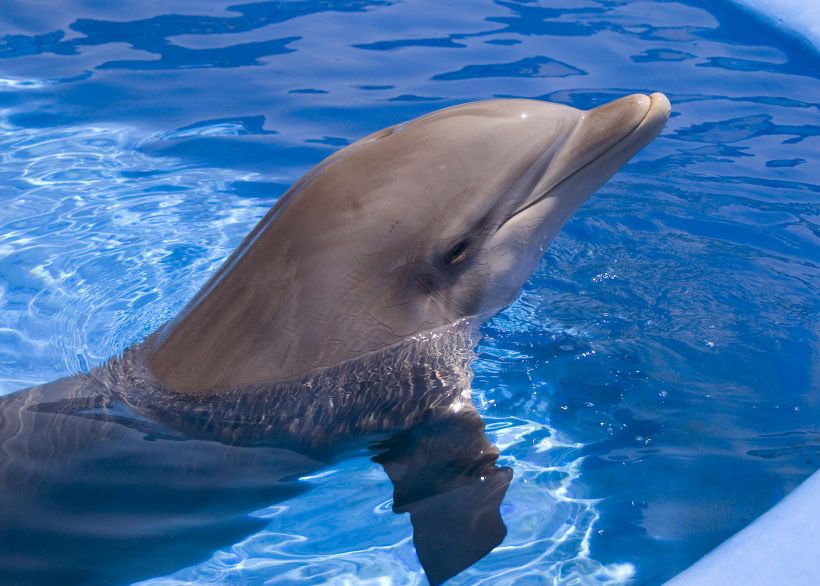Dolphin Therapy Smells Fishy

For some physically and mentally handicapped children, swimming with dolphins is a dream come true. That dream is shared by a multi-million dollar industry that provides so-called dolphin-assisted therapy for a few thousand dollars per session.
For the dolphins, the interactions with humans tend to be a nightmare.
Yet while laboratory animal are at least poked and prodded for some good for humankind, interacting with dolphins provides no long-term human health benefits and is largely an unproven therapy that can cheat patients out of real treatment, according to two recent studies.
Reason for depression
Dolphin-assisted therapy emerged in the 1970s as a possible treatment for depression and later as a means to help children with autism and other mental and physicals disorders. It is a therapy founded on good intentions.
One of the earliest advocates was John Lilly, the notorious California counterculture M.D. who, after heavy doses of LSD, claimed to communicate with dolphins — and aliens, for that matter. Although Lilly hoped the slaughter of whales would end once humans understood how smart the creatures were, his work has inadvertently nurtured a feel-good, international industry that indirectly supports the violent harvesting of dolphins from the wild — which, outside of U.S. law, can kill dolphins in the process and forces the survivors into captivity, where they are fed a diet of dead fish and must frolic before an audience thrice daily to the tune of "R-O-C-K in the USA."
Anecdotal evidence abounds on the Internet of dolphins making children feel better. Only one peer-reviewed study, however, from 2005, supports dolphin-assisted therapy, and this was a weak study at that. Published in the British Medical Journal, the study documented 25 adults with mild depression who were flown to Honduras for two weeks to either enjoy the beaches and play with dolphins, or just enjoy the beaches.
Sign up for the Live Science daily newsletter now
Get the world’s most fascinating discoveries delivered straight to your inbox.
Remarkably, all the patients felt less depressed, but the 13 patients who played with dolphins were slightly less depressed than the 12 patients stuck with just a free vacation.
Fishy studies
Admittedly, it is tough to pull off a classic, placebo-controlled study on dolphin-assisted therapy. Patients tend to know whether they are swimming with dolphins or, say, squid dressed like dolphins. If they can't tell the difference, then there's no fixing their depression.
Nevertheless, this was the strongest study in favor of dolphin-assisted therapy, according to a review by Anna Baverstock and Fiona Finlay of the Community Child Health Department in Bath, England, in a paper to be published in the Archives of Disease in Childhood, now available online.
Baverstock and Finlay conducted the review because a mother was seeking medical support for her son, and they needed to determine whether swimming with dolphins had any health benefits for children with cerebral palsy. The answer was no, or at best, dolphins were as equally effective at making children feel better as puppies, warm beaches or clowns.
Similarly, in September 2007 in the journal of the International Society for Anthrozoology, Lori Marino and Scott Lilienfeld of Emory University analyzed five studies supporting the use of dolphin-assisted therapy and found major methodological flaws in each one. The studies were either too small, prone to some obvious bias, or offered no long-term perspective.
Squeaking by
Two legitimate studies, however, provide some evidence that dolphins can affect human health, in theory. The more recent one comes from a Japanese group, published in the Journal of Veterinary Medical Science in 2006. The scientists found that dolphins increase their vocalizations when interacting with people and that this form of sonar, called echolocation, can penetrate the human body.
This complements work by a German group, published in the Journal of Theoretical Biology in 2003, which found that echolocation could have an effect on biological tissue under some circumstances if repeated over several days or weeks. Just what the effect would be is unclear and, nevertheless, 80 percent of the dolphin-therapy sessions the scientists analyzed didn't reach this level of interaction.
As the obscure journal titles might reveal, this is all fringe science. It may be that we are merely charmed by the dolphin's Joker-like smile, which of course isn't a smile but rather the natural shape of its mouth that fools us into thinking they like us.
- GALLERY: Endangered and Threatened Wildlife
- Special Report: Toward Immortality
- Amazing Animal Abilities
Christopher Wanjek is the author of the books “Bad Medicine” and “Food At Work.” Got a question about Bad Medicine? Email Wanjek. If it’s really bad, he just might answer it in a future column. Bad Medicine appears each Tuesday on LiveScience.

Christopher Wanjek is a Live Science contributor and a health and science writer. He is the author of three science books: Spacefarers (2020), Food at Work (2005) and Bad Medicine (2003). His "Food at Work" book and project, concerning workers' health, safety and productivity, was commissioned by the U.N.'s International Labor Organization. For Live Science, Christopher covers public health, nutrition and biology, and he has written extensively for The Washington Post and Sky & Telescope among others, as well as for the NASA Goddard Space Flight Center, where he was a senior writer. Christopher holds a Master of Health degree from Harvard School of Public Health and a degree in journalism from Temple University.










